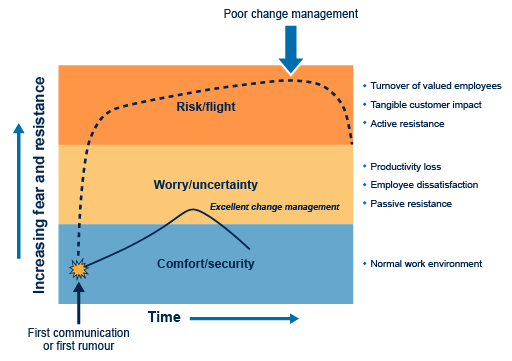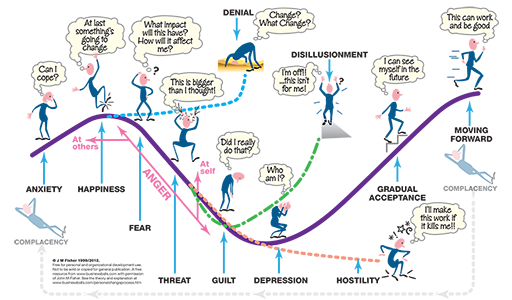1.1 Adapting to change
For many people, starting work or switching careers is a major change they need to adapt to. It can be exciting and lead to numerous opportunities. It can also require some planning to make the most of the new job, and changes it may have for your personal circumstances.
When joining the hybrid workforce, a number of specific skills and behaviours need to be learned in order to successfully manage the new expectations your employer may have.
Change management has long been an area of discussion within the workforce, but it is only recently that change management and hybrid working have been discussed together (Power, 2021; Lenka, 2021). Traditional models can be used to show how significant change, such as moving into the hybrid workforce for the first time, can lead to increased anxiety, dissatisfaction, and a loss in productivity.
Various change management models, such as those in Figures 1 and 2, depict similar issues, namely that without appropriately managing a change within the working environment, individuals can face fear, resistance, and depression, all of which significantly reduce their ability to work effectively (Fisher, 2012; Prosci, 2004). This is why it is so important to be prepared for change, to understand the difficulties you might face, and to improve any skills that may be needed to help manage this change.
Activity 2 Dealing with change
Look at the Fisher Curve (Figure 2) and think about a time when you have faced a significant change.
Where did you find yourself on the curve?
If it was in a negative part of the curve, how did you overcome those feelings?
If it was in a positive part of the curve, how did you make the most of those feelings?
Comment
Everyone reacts differently to change, so there are no right or wrong answers. You may find yourself at different points on the curve at different stages within a single change. If feeling angry or afraid, some people find it helpful to talk to friends and colleagues. Help may be available through your organisation, or charities such as Mind provide information on their website that may be useful. It is also important to build on times when you feel happy and excited; perhaps you could share your ideas of how the change could benefit you and your colleagues, or make suggestions to make the change even better?


